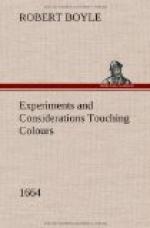observation among Dyers, That Clothes, which have
once been throughly imbu’d with Black, cannot
so well afterwards be Dy’d into Lighter Colours,
the praeexistent Dark Colour infecting the Ingredients,
that carry the Lighter Colour to be introduc’d,
and making it degenerate into Some more Sad one; Yet
the Experiments lately mention’d may shew us,
that where the change of Colour in Black Bodies is
attempted, not by mingling Bodyes of Lighter Colours
with them, but by Addition of such things as are proper
to alter the Texture of those Corpuscles that contain
the Black Colour, ’tis no such difficult matter,
as the lately mention’d Learned Men imagine,
to alter the Colour of Black Bodyes. For we saw
that Inks of several Kinds might in a trice be depriv’d
of all their Blackness; and those made with Logwood
and Red-Roses might also be chang’d, the one
into a Red, the other into a Reddish Liquor; and with
Oyl of Vitriol I have sometimes turn’d
Black pieces of Silk into a kind of Yellow, and though
the Taffaty were thereby made Rotten, yet the spoyling
of that does no way prejudice the Experiment, the change
of Black Silk into Yellow, being never the less True,
because the Yellow Silk is the less good. And
as for Whiteness, I think the general affirmation of
its being so easily Destroy’d or Transmuted
by any other Colour, ought not to be receiv’d
without some Cautions and Restrictions. For whereas,
according to what I formerly Noted, Lead is by Calcination
turned into that Red Powder we call Minium;
And Tin by Calcination reduc’d to a White Calx,
the common Putty that is sold and us’d so much
in Shops, instead of being, as it is pretended and
ought to be, only the Calx of Tin, is, by the
Artificers that make it, to save the charge of Tin,
made, (as some, of themselves have confess’d,
and as I long suspected by the Cheap rate it may be
bought for) but of half Tin and half Lead, if not far
more Lead than Tin, and yet the Putty in spight of
so much Lead is a very White Powder, without disclosing
any mixture of Minium. And so if you take
two parts of Copper, which is a High-colour’d
Metall, to but one of Tin, you may by Fusion bring
them into one Mass, wherein the Whiteness of the Tin
is much more Conspicuous and Predominant than the
Reddishness of the Copper. And on this occasion
it may not be Impertinent to mention an Experiment,
which I relate upon the Credit of a very Honest man,
whom I purposely enquir’d of about it, being
my self not very fond of making Tryals with Arsenick,
the Experiment is this, That if you Colliquate Arsenick
and Copper in a due proportion, the Arsenick
will Blanch the Copper both within and without, which
is an Experiment well enough Known; but when I enquir’d,
whether or no this White mixture being skilfully kept
a while upon the Cupel would not let go its Arsenick,
which made Whiteness its praedominant Colour, and
return to the Reddishness of Copper, I was assur’d




